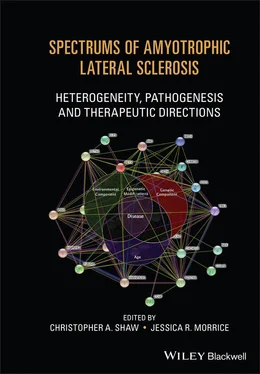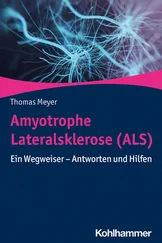From a clinical point of view, FTD and ALS overlap since 15–18% of ALS patients have FTD and 15% of FTD patients show motor dysfunctions [22, 23]. ALS and FTD also share genetic and neuropathological features, thus leading to the definition of the ALS/FTD spectrum where ALS and FTD are the extremes of a continuum. From a genetic point of view, this idea has been consolidated by the identification of the gene C9orf72 [24, 25], whose pathogenic expansion has been described in 30–50% of fALS, 25% of familial FTD, 5–7% of sALS, and 6% of sporadic FTD cases in different populations [26, 27]. Furthermore, other genes have been associated with the ALS/FTD spectrum: TBK1, TARDBP, FUS, and SQSTM1 [28]. Finally, with regard to neuropathology, TDP‐43 inclusions in neuronal cells are a hallmark of ALS as well as of a proportion of FTD.
Recent genetic evidence, along with clinical and pathological observations, indicate that ALS may be linked to primary muscle disorders as well. Mutations in valosin‐containing protein (VCP), previously identified in a proportion of patients with hereditary inclusion‐body myopathy (IBM), were later detected in a subset of sALS and fALS cases [29]. Additional genes, including MATR3, hnRNPA1, hnRNPA2B1, and SQSTM1, have been identified, which are responsible for an ALS/myopathy spectrum with overlapping phenotypes [30–32]. Interestingly, most myopathies associated with ALS are distal myopathies with evidence of rimmed vacuoles at muscle biopsy. These structures represent the accumulation of autophagic vacuoles due to lysosomal dysfunction or protein accumulation.
Paget's disease of the bone, extrapyramidal syndromes, psychiatric disorders, and peripheral neuropathies are additional conditions that are mechanistically linked to ALS. The spectrum of clinical phenotypes associated with major ALS‐associated genes is listed in Table 1.1[24, 25, 29, 30,32–66].
SOD1 is the only ALS‐associated gene that has been associated exclusively with an isolated motor phenotype. A common phenomenon for all other ALS genes is pleiotropy, which means a genetic variant can be associated with multiple phenotypic traits. The same genetic variant can cause not only different ALS subtypes in families, in terms of age of onset and disease course, but also different diseases. Examples of pleiotropic genes are C9orf72 and VCP . In the same family, C9orf72 carriers can have only ALS, only FTD, or overlapping ALS/FTD phenotypes. Furthermore, the same pathogenic variant in VCP has been detected in patients with ALS, FTD, IBM, and Charcot‐Marie‐Tooth type 2 (CMT2) [67]. The opposite is also true: different pathogenic variants in the same ALS‐associated gene can cause an identical phenotype.
TABLE 1.1 Spectrum of clinical disease phenotypes associated with genetic variants.
|
ALS |
FTD |
Myopathy |
Parkinson's disease |
Paget's disease |
Others |
| SOD1 |
+ 44 |
– |
– |
– |
– |
– |
| C9orf72 |
+ 24,25 |
+ 24,25 |
– |
+ 45 |
+/− 46 |
Psychiatric disorders [33], Huntington disease [34] |
| TARDBP |
+ 47,48 |
+ 49 |
– |
+ 50 |
– |
– |
| FUS |
+ 51,52 |
+ 53 |
– |
– |
– |
Hereditary essential tremor 4 [35] |
| NEK1 |
+ 54 |
– |
– |
– |
– |
Short‐rib thoracic dysplasia [36] |
| TBK1 |
+ 55 |
+ 56 |
– |
– |
– |
Herpes simplex encephalitis [37] |
| MATR3 |
+ 32 |
+ 32 |
+ 57 |
– |
– |
– |
| VCP |
+ 29 |
+ 58 |
+ 58 |
– |
+ 58 |
Charcot‐Marie‐Tooth type 2 [38] |
| SQSTM1 |
+ 30 |
+ 59 |
+ 60 |
– |
+ 61 |
Childhood‐onset neurodegeneration with ataxia, dystonia, and gaze palsy [39] |
| OPTN |
+ 62 |
+ 63 |
– |
+ 64 |
+ 65 |
Open angle glaucoma [40] |
| KIF5A |
+ 66 |
– |
– |
– |
– |
Hereditary spastic paraplegia [41], Charcot‐Marie‐Tooth type 2 [42], neonatal intractable myoclonus [43] |
Presence (+) or absence (−) of clinical signs in patients with variants in different genes is reported in the table.
High‐throughput sequencing studies have shown that a consistent number of patients with the C9orf72 expansion have additional variants in other ALS‐associated genes, suggesting that pleiotropy can be explained by an oligogenic model [5, 27,68–70].
With rare exceptions, it is not possible to establish a genotype–phenotype correlation in ALS. The variants p.D11Y, p.D90A, and p.G93D in SOD1 are associated with a relatively benign form of motor neuron disease with distal limb distribution [71–74], while p.A4V and p.G85S are associated with a rapid course [75, 76]. Some mutations in FUS, including p.P525L and frameshift mutations, are frequently associated with juvenile‐onset ALS with an aggressive course [77–79].
GENETIC MODELS TO STUDY ALS
In Vivo Models
ALS is currently untreatable. Riluzole and edaravone, the two drugs approved by the US Food and Drug Administration (FDA), increase survival by a few months, blocking excessive glutamatergic neurotransmission and preventing oxidative stress damage, respectively, but they are not able to halt or cure the disease [80]. Genetic models represent a very useful tool to identify the concrete target of new drugs. Of course, no model can fully reproduce the human condition, especially its clinical heterogeneity, but a combination of in vitro and in vivo models can help to investigate the mechanisms underlying the disease and explore epistatic interactions. Since the first genetic discoveries, molecular biology techniques have made it possible to insert gene mutations and express mutant proteins in a number of animal models (see details in Chapter 8). Small animals such as Drosophila melanogaster and Danio rerio (zebrafish), have been widely used due to the simplicity and rapidity of manipulations, especially for drug screening. The zebrafish has many advantages in this sense, mostly because it is a vertebrate and has high genetic homology with humans. The zebrafish can be used at the embryonic stage, taking advantage of egg transparency and its rapid development, which can be followed in real time; and also at the adult stage, using transgenic lines. Motor phenotypes can be easily detected and analyzed, and in vivo imaging can be promptly performed. Genetic interactions can be tested as well as mechanisms of action of pathogenesis. High‐throughput drug screening can be done to test libraries containing thousands of chemical compounds at the same time. Since the zebrafish is not a mammal and does not have UMNs (the corticospinal and rubrospinal tracts are absent), it can be considered a very useful tool to study cellular dynamics in vivo and may be used prior to other models, such as rodents [81, 82].
A wide range of murine models has been created [83] but the most commonly used remains the first one developed: a transgenic strain carrying the SOD1 G93Apathogenic variant [84]. This model has been used to test most drugs in preclinical phases. It should be noted that these treatments are administrated at the pre‐symptomatic stage, whereas ALS patients are treated after a disease onset that seems to be preceded by a long pre‐symptomatic period. To better investigate the pre‐symptomatic stage, a SOD1 pig model has recently been obtained [85]. Since pigs have a long lifespan, transgenic pigs, stably expressing the human pathological allele SOD1 G93A, have a pre‐symptomatic phase of about 27 months. After this period, gait abnormality and concomitant dysphagia appear and progress rapidly with severe respiratory impairment. SOD1 animal models have been used in preclinical investigations of almost all drugs used in clinical trials. However, the principal limit of this model is that TDP‐43 pathology, which is present in about 97% of all ALS subtypes, is not detected in SOD1 mutated patients, suggesting different disease mechanisms. In addition, preclinical studies performed in mice have failed to be transferred to humans [86].
Читать дальше

![Ники Сегнит - Тезаурус вкусов 2. Lateral Cooking [litres]](/books/430786/niki-segnit-tezaurus-vkusov-2-lateral-cooking-li-thumb.webp)



